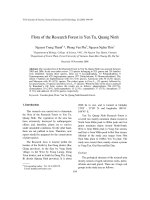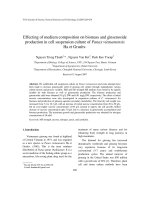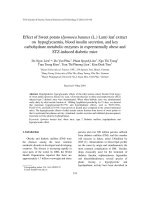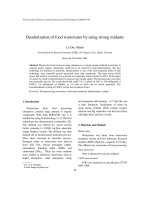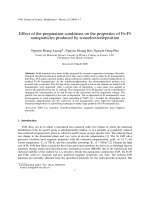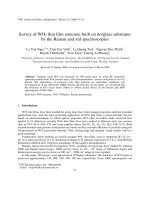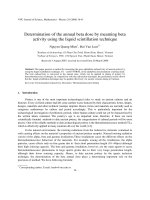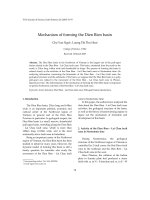Báo cáo " Effect of pomelo (citrus grandis (l). osbeck) peel extract on lipid-carbohydrate metabolic enzymes and blood lipid, glucose parameters in experimental obese and diabetic mice " doc
Bạn đang xem bản rút gọn của tài liệu. Xem và tải ngay bản đầy đủ của tài liệu tại đây (114.21 KB, 9 trang )
VNU Journal of Science, Natural Sciences and Technology 26 (2010) 224-232
224
Effect of pomelo (citrus grandis (l). osbeck) peel extract on
lipid-carbohydrate metabolic enzymes and blood lipid, glucose
parameters in experimental obese and diabetic mice
Do Ngoc Lien
1,
*, Nguyen Thi Thuy Quynh
1
, Do Van Phuc
1
,
Vu Cong Phong
2
, Phung Thanh Huong
3
1
Faculty of Biology, College of Science, VNU, 334 Nguyen Trai, Hanoi, Vietnam
2
Pedagogical University of Ha Noi No-2
3
Hanoi University of Pharmacy
Received 18 January 2010
Abstract. The aim of this study was to assess the effects of Pomelo (Citrus grandis (L.) Osbeck)
peel extracts (CGE) on activity of lipid-carbohydrate metabolic enzymes such as Carnitine
pamitoyl-transferase (CPT), lipase, hexokinase, glucose 6-phosphatase and blood lipid glucose
parameters in experimental obese and diabetic mice. The results showed that, in the experimental
obese mice treated daily, orally with CGE at dose of 1200 mg/body weight for three weeks,
activity of hepatic CPT have been raised from 30.5% (for ethanol extract) to 63.3% (for ethyl
acetate extract) compared to the control. Simultaneous increase of blood lipolytic activity was
demonstrated in obese mice treated daily by CGE in comparison with the control. In addition,
body weight reducing and hypolipidemic effect of the CGE in obese mice were proven clearly.
Interestingly, the anti-diabetic effect of CGE in diabetic STZ induced mice was demonstrated.
Fasting blood glucose levels in diabetic mice treated orally with CGE (1200 mg/kg.b.w) for three
weeks were reduced clearly in comparison with the control (diabetic mice untreated) (p< 0.001).
Especially, hepatic hexokinase activity in diabetic mice treated with CGE was raised from 14.19%
(for ethanol extract) to 55.46% (for ethyl acetate extract) in comparison with the control (untreated
diabetic mice). On the contrary, activity of hepatic glucose 6-phosphatase in treated diabetic mice
was decreased clearly as compared to untreated diabetic mice (p<0.05).
Keywords: Citrus grandis (L.) Obeck, blood glucose and lipid, obese and streptozotocin diabetic
mice, hypolipidemic, anti-diabetic effect.
1. Introduction
∗
Obesity is the most common nutritional
disorder in the developed country and
developing in other countries including
Vietnam. It is considered to be a risk factor
_______
∗
Corresponding author. Tel.: 84-4-38582179.
E-mail:
associated with the development of major
human diseases such as cardiovascular disease,
diabetes mellitus and cancer.
The anti-obesity and anti-diabetic drugs
were developed following the approval process
commonly reserved for conventional
pharmaceuticals under the guideline of the US
Food and Drug Administration (FDA. 2004),
such as orlistat, metformin etc [1].
D.N. Lien et al. / VNU Journal of Science, Natural Sciences and Technology 26 (2010) 224-232
225
Orlistat, hydrogenated derivative of liptatin
derivated from Streptomyces toxitricini, is a
potent inhibitor of gastric pancreatic lipase and
has proved to be moderately effective for
treatment of human obesity and, possibly
diabetes [2].
Anti-hyperlipidemic and anti-diabetic effect
of metformin were showed, but side-effect and
its efficacy of remains in debate if its use for a
long time. It is has been suggested that herbal
remedies from traditional medicinal plants have
to be investigated, in the future, for treatment
and prevention of obesity and diabetes and
other diseases.
The investigation of effects of plant extracts
on activity of lipid-carbohydrate metabolic
enzymes such as lipase, lipoprotein lipase,
carnitine acyl transferases, hexokinase, an
important enzyme of carbohydrate degradation
and glucose 6-phosphatase, an important
enzyme of gluconeogenesis in liver of animals
have been interested by scientists for
elucidation of anti-obesity and anti-diabetes
mechanism of traditional remedies. Inhibition
of enzymatic activity of the digestion and
absorption of dietary fat such as lipase,
lipoprotein lipase and enhancement of carnitine
acyl transferases activity and fatty acid
oxidation enzymes in fat expenditure in the
mitochondria have been also used as target in
obesity treatment [2,3].
Pomelo (Citrus grandis (L.) Osbeck)
belonging to the family Rutaceae, is a fruitful
plant found widely in Vietnam with many
different cultivars. Its peels being major by-
product in the processing of Citrus juice
become waste and cause environmental
pollutions. The previous studies showed that,
polemo peels are abundant of bioactive
compounds such as flavonoid, pectin,
naringenin, hesperidin, naringin, kaemferol and
its derivates … [4].
The present study was carried out to assess
anti-obesity, anti-diabetic effects and the
expression of activity of some lipid-
carbohydrate metabolic enzymes in
experimental obese and diabetic mice. The aim
of this study is to elucidate some biochemical
mechanism of traditional anti-obesity and anti-
diabetes remedy.
2. Materials and methods
2.1. Plant material and preparation of plant
extract
The Pomelos were collected from Hanoi
during the months of August-September, 2009.
The plant materials were classified by Botany
Department at Vietnam National University,
Hanoi.
Pomelo peels were dried at 50
0
C grinded
into powder and extracted 3 times with ethanol
with continuously stirring. The mixture was
filtered with Whatman No.1 filter paper and the
filtrate was centrifuged at 6.000 rpm at room
temperature (25
0
C). The supernatant was
concentrated in vacuum by means of rotary
evaporator at 40
0
C to obtain concentrates. This
concentrate was dissolved in distilled water and
fractionated in turn via n- hexane, chloroform,
ethyl acetate solvents. The extracting portions
were concentrated to obtain concentrates. All
the concentrates were stored at 4
0
C until use [5,
6].
2.2. Animals and diets
Male Swiss strain mice weighing 14-16g at
four weeks of age (NIHE) were used in this
study. Animals were housed at 25±2
0
C with
12h light/dark cycle. Mice were divided into
two groups with different diets. One was fed
normal standard pellet diet (ND) supplied by
D.N. Lien et al. / VNU Journal of Science, Natural Sciences and Technology 26 (2010) 224-232
226
National Institute of Hygiene Epidemiology
(NIHE). Another was fed high-fat died (HFD).
HFD was prepared by mixing the normal chow
(NIHE) with high lipid and cholesterol diet
according to National Institute of Nutrition
(NIN) and Srinivasan et al [5]. Animals had
free access to diet and water (ad libitum) in 6
weeks.
2.3. Determination of hypolipidemic and body
weight reducing effect of pomelo peel extracts
in obese mice
After 6 weeks care, mice from each group
were divided into different lots (6 mice/ lot).
Each lot of mice was treated daily with
1200mg/kg concentrate of ethanol, n-hexan,
chloroform, ethyl acetate and 500mg/kg
metformin respectively for three weeks. The
mice fed ND are untreated as the control. Body
weight of mice was determined weekly and on
the final day of the experience, blood of all
mice was collected for analysis. Blood lipid
parameters, including total cholesterol (TC),
triglyceride (TC), HDL-c, LDL-c, and was
assayed using Biochemical automatically
analyzer AU640, Japan.
2.4. Evaluation of hypoglycemic effect of CGE
in STZ induced diabetic mice
On the final day of 6 weeks care, fasting
blood glucose levels of mice fed ND and fed
HFD were determined, then obese mice were
given single i.p injection of Streptozotocin
(STZ) at dose 120mg/kg (STZ was freshly in
0.1M citrate buffer pH 4.5) and blood glucose
was monitored after 72h. Only mice with
fasting blood glucose levels >18mmol/l in
tandem with expressed blood insulin were
considered to be type 2 diabetes. Blood insulin
concentration of mice was determined by
ELISA kit technique (Mercodia, Sweden). For
studying hypoglycemic effect of pomelo peel
extracts, diabetic mice were divided into
different lots administrated daily with
1200mg/kg concentrate of ethanol, n-hexan,
chloroform, ethyl acetat extracts and 500mg/kg
metformin respectively for three weeks. Fasting
blood glucose levels were determined weekly
by Technique (USA) One Touch Ultra in all the
experience.
2.5. Determination of blood and liver enzymatic
activity of mice
Activity of blood lipase was determined by
automatic analyzer AU640, Japan. Hepatic CPT
Activity was determined by technique of
Markwell et al [6]. Hexokinase (HK) activity
was determined using a spectrophotometric
assay as described by Darrow and Colowick in
where the formation of glucose 6-phosphate at
37°C was coupled to its oxidation by glucose-6-
phosphate dehydrogenase and NAD
+
[7-9].
Hepatic glucose-6-phosphatase activity was
determined based on hydrolytic reaction of
glucose-6-phosphate to produce inorganic
phosphorus (P
i
). Produced P
i
was quantified
according to the method described by Taussky
[10]. The protein concentration was measured
by the method of Bradford using bovine serum
albumin as the standard [11].
2.6. Statistic analysis
All values are expressed as the mean ± S.D.
The results were analyzed for statistical
significance by one-way ANOVA test using
SPSS software. Changes were considered
significant if the P-value was less than 0.05 or
0.01.
3. Results and discussion
3.1. Body weight and blood biochemical
parameters with different nutrition diets
D.N. Lien et al. / VNU Journal of Science, Natural Sciences and Technology 26 (2010) 224-232
227
Fig. 1. Body weight gain of mice groups with ND and HFD after 6 weeks care (p< 0.05).
Table 1. Blood biochemical parameters of mice groups fed with ND and HFD diet
Parameters ND group HFD group Changes, times
Total Cholesterol (TC). mmol.l
-1
3.17 ± 0.1 5.93± 0.41 ↑ 1.9
Triglyceride (TG).mmol.l
-1
1.18 ± 0.17 6.03 ± 0.19 ↑ 5.1
LDL-c mmol
-1
0.92 ± 0.12 2.08 ± 0.1 ↑ 2.3
Free fatty acid (FFA) mmol.l
-1
0.81 ± 0.1 1.37 ± 0.1 ↑ 1.7
Glucose mmol.l
-1
5.47 ± 0.35 9.61 ± 0.37 ↑ 1.8
Serum Insulin (SI) ng.ml
-1
0.60 ± 0.01 1.56 ± 0.17 ↑ 2.6
HDL-c mmol.l
-1
1.72 ± 0.1 1.09 ± 0.08 ↓ 1.6
Lipase U.l
-1
90.2 ± 13.06 41.2 ± 7.73 ↓ 2.2
(↑): increase, (↓) decrease
The obtained results show that the body
weights of HFD-fed mice were increased
approximately 1.8 times compared to the ND-
fed mice (Fig.1). There is great difference in
blood biochemical parameters between these
groups. Particularly, blood TC, TG, LDL-c,
glucose and insulin of fed HFD groups were
increased respectively 1.9, 5.1, 2.3, 1.8, and 2.6
times compared to fed ND mice. While,
concentration of HDL-c and enzymatic activity
of lipase decreases respectively 1.6 times and
2.2 times as compared to ND fed mice (table 1).
These results have affirmed that the
experimentally obese mice suffer from lipid-
carbohydrate metabolism disorder.
3.2. Effect of orally treated with C. grandis peel
extract fractions on obese mice
In order to treat the obese mice, we have
designed the experimental schema for daily
repeated oral administration (for three weeks)
of CGE fractions (1200mg/kg b.w). Obtained
results show that anti-obesity effect of CGE
was proved clearly to reduce body weight of
HFD-fed mice. Namely body weight of HFD-
fed mice administrated with ethyl acetate
extract fraction was reduced clearly (32.04%)
than untreated obese mice. Whereas body
weight of untreated HFD lot raised normally
(7.51%) (Table 2).
34,77
39,82
44,54
52,84
29,95
24,56
15,43
15,37
19,76
17,4
23,83
26,97
30,2
34,56
0
10
20
30
40
50
60
W0 W1 W2 W3 W4 W5 W6
Body wight (gram)
HFD ND
D.N. Lien et al. / VNU Journal of Science, Natural Sciences and Technology 26 (2010) 224-232
228
Table 2. Effect of pomelo peel extract fractions on body weight after 21 days of oral administration
Body weight
W
0
W
1
W
2
W
3
Chargers, %
HFD + Ethanol 52.15±2.34 48.23 ± 2.13 45.58 ± 2.13 43.84 ± 2.14 ↓ 20.53
HFD + hexan 51.49±2,13 49.69 ± 2.14 48.42 ± 1.56 47.78 ± 2.34 ↓ 13.39
HFD + chloroform 49.58 ± 2.14 48.02 ±1.98 46.89 ± 1.44 46.32 ± 2.56 ↓ 16.04
HFD + Ethylacetate 51.9 ± 2.18 45.79 ± 1.34 40.88 ± 1.82 37.49 ± 2.15 ↓ 32.76
HFD + untreated 51.32 ± 2.10 52.81 ±1.36 53.82 ± 2.13 55.17 ± 1.24 ↑ 7.51
HFD + metformin 52.26 ±2.14 50.39 ± 2.21 48.67 ± 2.15 47.45 ± 2.33 ↓ 13.99
At the same time, hypolipidemic effect of
C.grandis peel extracts on blood TC, TG, LDL-
c concentrations of obese mice was
demonstrated clearly (fig.2). Especially body
weight of obese mice with ethyl acetate fraction
was reduced 32.76% as compared to control
(untreated obese mice).
6.11
5.88
1.96
1.13
4.59
4.21
1.41
1.29
3.92
3.15
1.34
1.38
0
1
2
3
4
5
6
7
Total Cholesterol
(TC) mmol/l
Triglyceride (TG)
mmol/l
LDL-c mmol/l HDL-c mmol/l
Untreated EtOH EtOAc
Fig. 2. Effect of repeated oral administration (for three weeks) of C.grandis peel extract fractions
on lipidemic parameter.
Namely, blood cholesterol, triglyceride and
LDL-c levels of lot of mice fed HFD were
decreased clearly (fig. 2).
3.3. Effect of C. grandis peel extracts fractions
on enzymatic activities of lipase and CPT in
obese mice.
Obtained results showed that blood lipolytic
activity in obese mice treated with ethanol and
ethyl acetate fractions were increased clearly
from 18.51% to 21.48% respectively in
comparison with the control (untreated obese
mice) (Fig.3. A). Especially, CPT, an enzyme
enhancing lipid degradation has expressed
raising activity in obese mice treated with CGE.
The results showed that hepatic CPT activity in
treated obese mice were increased from 30.5%
(for ethanol fraction) to 63.3% (for ethyl acetate
fraction) in comparison with the control
(untreated obese mice mice) (0.01<p) (Fig.3.
B). In addition, the increase of CPT activity in
mice treated with ethyl acetate fraction was
raised more than that treated with ethanol
fraction (p<0.01). (Fig.3. B)
D.N. Lien et al. / VNU Journal of Science, Natural Sciences and Technology 26 (2010) 224-232
229
49.2
40.5
48
0
10
20
30
40
50
60
HFD + Untreated HFD + Ethanol HFD + Etthylacetate
Lipase (U/I) activity
A
23.45
14.36
18.74
0
5
10
15
20
25
30
HFD + Untreated HFD + Ethanol HFD + Etthylacetate
CPT(mol.m
-1
mg Protein
-1
) activity
B
Fig.3. Effect of C. grandis peel extract fractions on enzymatic activities of lipase (A) and
CPT(B) in treated obese mice (↑ Increases).
3.4. Effect of STZ on ND-fed and HFD fed mice
Injection of STZ (120 mg/kg) into obese
mice significantly increased blood glucose
concentration (p < 0.001), with recorded values
being over 4 times greater than fed ND mice
(p<0.01). However, blood glucose
concentration in fed ND mice injected with
STZ (120 mg kg
-1
) increased slightly (about 1.5
times, p > 0.05) as compared to buffer injected
ND fed mice untreated with STZ and equivalent
to HFD. In addition, serum insulin level in HFD
mice significantly increase (2.7 times) in
comparison with ND fed mice (Table 3). It is
clear that, obese mice injected with STZ at dose
(120mg/kg w.b) suffer from type 2 diabetic
disease expressed insulin mutinously insulin
resistance. Therefore, the carbohydrate
metabolic disorder and insulin resistance were
proved in the STZ induced diabetic mice
Table 3. Blood glucose and insulin concentration after 5 days of buffer or STZ injection
Biochemical estimation ND ND + STZ HFD HFD + STZ
Blood glucose (mmol/l)
Initial 4.85 ± 0.64 5.87 ± 1.15 8.76 ± 1.07 9.15 ± 1.13
After 5 days of injection 5.42 ± 0.72 8.36 ± 1.08 8.43 ± 1.04 23.25 ± 4.14
Serum insulin (ng/ml) 0.63 ± 0.03 0.59 ± 0.05 1.71 ± 0.1 0.98 ± 0,08
ND: normal diet fed mice injected with citrate buffer (control), ND +STZ: normal diet fed mice injected
with STZ (120 mg/kg).
HFD: high fat diet fed mice injected with citrate buffer (control), HFD + STZ: high fat diet fed mice
injected with STZ (120mg/kg)
All values were expressed as mean ± S.D. Value are statistically significant at
*
p < 0.01 and
**
p < 0.001.
3.5. Hypoglycemic effect of pomelo extracts
fractions on type 2 diabetic mice
The treatment of diabetic mice with ethanol,
ethyl acetate fractions (1200 mg/kg w.b) and
metformin 500mg/kg w.b for three weeks have
reduced significaly their blood glucose levels
32.38%, 41.50% and 28.84% respectively
(p<0.001). Interestingly, blood glucose level in
diabetic mice treated with ethyl acetate fraction
was reduced strongly more than that treated
with anti-diabetic metformin (p<0.05) (Table
4).
↑18.51%
↑21.48%
↑30.5%
↑63.3%
D.N. Lien et al. / VNU Journal of Science, Natural Sciences and Technology 26 (2010) 224-232
230
Table 4. Hypoglycemic effect of three weeks administration of pomelo peel extract
and fractions in STZ induced diabetic mice, glucose mmol/l
After treatment
Starting point
Week 1 Weeks 2 Weeks 3 Changes, %
DM (untreated) 21.0 ±2.4 20.2±2.0 20.2 ±2.0 22.1±1.5 ↑4.93
DM + Metformin 20.8±1.6 17.5±2.4
c
15.8±2.5
c
14.8±2.1
c
↓ 28.84
DM + EtF 21.0±2.4 18.2±3.0
a
15.8±2.2
a
14.2±1.9
a
↓ 32.38
DM + EaF 21.2±3.0 18.0±2.5
b
15.0±2.1
b
12.4±1.8
b
↓ 41.50
DM + HF 22.5±2.0 18.6±3.1 19.5±2.3 20.9±3.5 ↓ 7.11
DM + CF 20.3±2.3 18.5±2.2 17.5±1.9 18.7±1.8 ↓ 7.88
EtF: ethanol fraction, EaF: ethyl acetate fraction, HF: n-hexan fraction, CF: chloroform fraction. All values were
expressed as mean ± S.D. Value are statistically significant at
a
p<0.05,
b
p < 0.01 and
c
p < 0.001. Value in
parenthesis indicates the percentage lowering of blood glucose in comparison to the before treatment. (↑: increase,
↓: decrease) .
While, blood glucose level of diabetic mice
treated with n-hexane, chloroform fractions
were reduced only slightly.
3.6. Effect of CGE on activities of Hexokinase
and glucose-6-phosphatase in diabetic mice
The results showed that, after three weeks
of treatment with ethanol and ethyl acetate
fractions, hepatic hexokinase activity in treated
CGE diabetic mice was increased from 14.9%
(for ethanol fraction) to 55.46% (for ethyl
acetate fraction) in comparison with untreated
diabetic mice (p<0.001). However, hexokinase
activity in normal non-diabetic mice was bigger
about two times in comparison with treated or
untreated diabetic mice (Fig.4A) Therefore, it is
necessary to treat for long time with CGE to
restore hexokinase activity. On the contrary,
there was a significant reduction in hepatic
glucose-6-phosphatase activity in type 2
diabetic mice treated with CGE as compared to
the untreated diabetic group. Namely, hepatic
glucose-6-phosphatase activity in type 2
diabetic mice treated with CGE was decreased
from 38.71% (for ethanol fraction) to 47.85%
(for ethyl acetate fraction) (p < 0.05) (Fig. 4B).
Seeing that, glucose 6-phosphatase, an
important enzyme is necessary for
gluconeogenesis pathway in the liver [3, 12].
Anti-diabetic effect of CGE was indicated
clearly by inhibition of glucose 6-phosphatase
activity in this study (Fig 4B).
10,37
1,34
4.58*
1.86*
5.23**
1.14**
7.12**
0.97**
0
2
4
6
8
10
12
Hexokinase (A) G 6-Pase (B)
activity, mU/ mg protein
NDM
DM untreated
DM+EtF
DM + EaF
Fig. 4. Effect of ethanol fraction and ethyl acetate
fraction of Citrus grandis (L.) Osbeck peel on
hepatic hexokinase and glucose-6-phosphatase
activity in STZ-induced diabetic mice.
NDM: non-diabetic, DM: diabetic, EtF: ethanol fraction,
EaF: ethyl acetate fraction, Data are expressed as means ±
S.E.M, n=6.
*
and
**
indicate the significant levels of
difference in glycogen level, hexokinase and glucose-6-
phosphatase as compared to non-diabetic and untreated
diabetic mice, respectively (
*
p < 0.05, ** p<0.01).
Conclusion
1. Body weight reducing, anti-obesity and
anti diabetic effects of CGE were proven in
D.N. Lien et al. / VNU Journal of Science, Natural Sciences and Technology 26 (2010) 224-232
231
experimental obese and type 2 diabetic mice
treated orally, daily for three weeks at the dose
of 1200mg/kg b.w of dry CGE fractions.
2. Activity of lipid degrading enzymes such
as lipase, CPT in obese mice treated with CGE,
was demonstrated to be increased from 18.51%
to 21.48%( for lipase) and from 30.50% to
63.30% (for CPT) in comparison with
untreated obese mice.
3. Activity of glucose degradation of
hexokinase in CGE treated diabetic mice was
increased strongly from 14.9% (for ethanol
fraction) to 55.46% (for ethyl acetate fraction)
in comparison with untreated diabetic mice
(p<0.001). On the contrary, activity of hepatic
glucose 6- phosphatase of glucoseneogenesis in
type 2 diabetic mice treated with CGE was
proved to be decreased clearly from 38.71%
(for ethanol fraction) to 47.85% (for ethyl
acetate fraction) as compared to untreated
diabetic mice.
Acknowledgements
Authors are thankful to support of the
project QGTD. 08.06. of Vietnam National
University, Hanoi.
References
[1] D.A. Moreno, N. lic, A. Pouler I. Raskin, Effect
of Arachis hypogaea nutshell extract on lipid
metabolic enzymes and obesity parameters. Life
sciences 78 (2006) 2797- 2803.
[2] Ide T. Effect of dietary α-linolenic acid on the
activity and gene expression of hepatic fatty acid
oxidation enzymes. Biofactors 13 (2000) 9-14.
[3] J. M. Berg, J. L. Tymoczko, L. Stryer,
Glycolysis and Gluconeogenesis. In.
biochemistry W.H freeman and Company, New
York (2001) 425-464.
[4] Y.C. Wang, Y.C. Chuang, H. W. Hsu, The
flavonoid, carotenoid and pectin content in peels
of citrus cultivated in Taiwan, Food Chemistry,
106 (2008) 277-284.
[5] K. Srinivasan , B. Viswanad , L. Asrat , C.L.
Kaul , P. Ramarao Combination of high-fat diet-
fed and low – done streptozotocin-treated rat A
model for type 2 diabetes and pharmacological
sceening, Pharmacological Reseach 52 (2005)
313-320.
[6] M. A. K. Markwell, E. J. Macgroarty,L.L.
Bieber, N. E. Tolbert, The sub cellular
distribution of carnitine acyl tranferrases in
mammlian liver and Kidney. J.Biochem. 248
(1973) 3426-3432.
[7] S. Bhavana, S. K. Satapathi, P. Roy
Hypoglycemic and Hypolipidemic effect of
Aegle marmelos L. leaf extract on Streptozotocin
induced diabetic mice. International Journal of
Pharmacology 3 (6) (2007) 444-452.
[8] H. U. Bergmeyer, K. Gawehn, and M. Grassl,
Methods of Enzymatic Analysis (Bergmeyer,
H.U. ed.), Second Edition, Vol.1 (1974) 434-
435.
[9] U.I. Jung, M. K. Lee, K. S. Jeong, M. S. Choi
The hypoglycemic effects of hesperidin and
naringin are partly mediated by hepatic glucose-
regulating enzymes in C57BL/KsJ-db/db mice,
Journal of Nutrition, 134 (2004) 2499-2503.
[10] H.H. Taussky, E. Shorr, A microcolorimetric
method for the determination of inorganic
phosphorus, The Journal of Biological
Chemistry 202 (1952) 675 – 685.
[11] M. A. Bradford. Rapid and Sensitive Method for
the quantification of microgram quantities of
Protein Utilizing the Principle of Protein-Dye
Binding, Anal. Biochem. 72 (1976) 248-254.
[12] N.Z. Banquer, D. Gupta, J. Raju, Regulation of
metabolic pathways in liver and kidney during
experimental diabetes effects of anti-diabetic
compounds. Indian Journal Clinical
Biochemistry, 13 (1998) 63-68.
D.N. Lien et al. / VNU Journal of Science, Natural Sciences and Technology 26 (2010) 224-232
232
Tác dụng của dịch chiết cùi bưởi (Citrus grandis (L.) Obeck)
đến một số enzyme trao đổi lipid-saccarit và các chỉ số lipid,
glucose máu trên chuột béo phì và đái tháo đường
thực nghiệm
Đỗ Ngọc Liên
1
, Nguyễn Thị Thuý Quỳnh
1
, Đỗ Văn Phúc
1
,
Vũ Công Phong
2
, Phùng Thanh Hương
3
1
Trường Đại học Khoa học Tự nhiên, Đại học Quốc gia Hà Nội
2
Trường Đại học Sư Phạm Hà Nội 2
3
Trường Đại Học Dược Hà Nội
Mục đích của nghiên cứu này là đánh giá tác dụng của dịch chiết cùi bưởi (Citrus grandis (L.)
Obeck) (CGE) lên một số enzyme trao đổi lipid- saccharid như carnitine panmitoyl-transferase (CPT),
lipase, hexokinase, glucose 6-phosphatase và một số chỉ số lipid và đường glucose huyết của chuột
béo phì và đái tháo đường thực nghiệm. Các kết quả nghiên cứu cho thấy rằng: ở chuột béo phì thực
nghiệm được xử lý hằng ngày bằng đường uống với dịch chiết cùi bưởi ở liều lượng 1200 mg/kg thể
trọng trong ba tuần, hoạt động của enzyme CPT ở gan tăng lên từ 30,5% (đối với dịch chiết ethanol)
đến 63.3% (đối với dịch chiết ethyl acetate) so với đối chứng (chuột béo phì không đựơc uống dịch
chiết cùi bưởi). Hoạt động lipase của máu cũng được nhận thấy tăng lên đồng thời ở chuột béo phì khi
được xử lý hằng ngày với dịch chiết cùi bưởi từ 18,51% đến 24,48% so với đối chứng. Thêm vào đó,
tác động làm giảm trọng lượng và mỡ máu cuả dịch chiết cùi bưởi cũng được chứng minh rõ ràng ở
chuột béo phì thực nghiệm. Điều dáng chú ý là dịch chiết cùi bưởi còn có tác dụng chống đái tháo
đường ở chuột gây đái tháo đường thực nghiệm. Cụ thể là nồng độ đường huyết lúc đói của chuột đái
tháo đường khi được điều trị 3 tuần bằng 1200mg/kg cao dịch chiết cùi bưởi đã giảm xuống rõ ràng từ
32,5% (uống cao cồn tổng số) đến 42,4% (uống cao ethyl acetat) so với đối chứng (P<0.01). Đặc biệt
là hoạt động hexokinase ở gan chuột đái tháo đường khi xử lý với dịch chiết cùi bưởi đã tăng lên từ
14,19% (đối với cao cồn tổng số) đến 55,46% (đối với cao ethyl acetat) so với đối chứng. Trái lại, hoạt
động glucose 6-phosphatase ở gan chuột đái tháo đường đựơc xử lý với dịch chiết cùi bưởi giảm
xuống rõ so với chuột đái tháo đường không xử lý dịch chiết cùi bưởi (p<0.05).
Từ khóa: Citrus grandis (L.) Obeck ,glucose và lipid máu, chuột béo phì, chuột đái tháo đường,
STZ.
